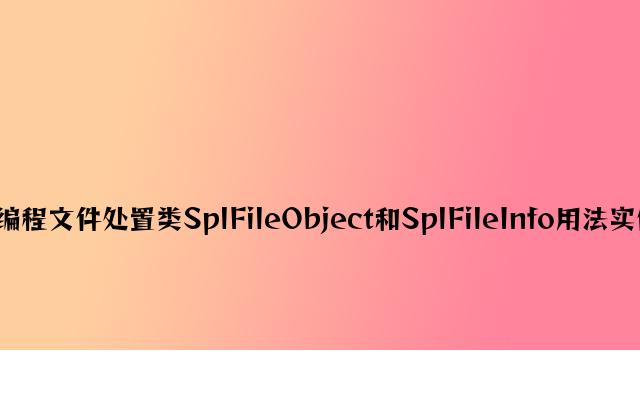
本文实例讲述了PHP编程文件处理类SplFileObject和SplFileInfo用法。分享给大家供大家参考,具体如下:
php对于大文件的处理除了用以下方法外还可以直接调用linux命令
文件处理类:
SplFileInfo {
/* 方法 */
public __construct ( string $file_name )
public int getATime ( void ) //获取文件的最后访问时间
public string getBasename ([ string $suffix ] ) //获取文件的没有路径信息的基本名称,参数可以为文件后缀,若有参数则返回没有该后缀的文件基本名称。
public int getCTime ( void ) //返回文章最后一次变更的时间戳。
public string getExtension ( void ) //获取文件扩展名
public SplFileInfo getFileInfo ([ string $class_name ] ) //以对象的形式返回文件路径和名称
public string getFilename ( void ) //获取文件名称,不带路径
public int getGroup ( void ) //获取文件所在组,返回组id
public int getInode ( void ) //获取文件索引节点
public string getLinkTarget ( void ) //获取文件链接目标
public int getMTime ( void ) //获取最后修改时间
public int getOwner ( void ) //获取文件的所有者
public string getPath ( void ) //获取文件路径,不带文件名和最后的斜杠
public SplFileInfo getPathInfo ([ string $class_name ] ) //返回路径对象
public string getPathname ( void ) //获取文件路径
public int getPerms ( void ) //获取文件权限
public string getRealPath ( void ) //获取文件绝对路径,若文件不存在,返回false
public int getSize ( void ) //返回文件大小,单位字节
public string getType ( void ) //返回文件类型,可能是 file, link, dir
public bool isDir ( void ) //判断是否是目录,是放回true否则返回false
public bool isExecutable ( void ) //判断文件是否可执行,返回true,否则返回false
public bool isFile ( void ) //如果文件存在且是一个普通文件(不是链接),返回true,否则返回false
public bool isLink ( void ) //判断文件是否是连接,不是返回false
public bool isReadable ( void ) //判断文件是否可读,可读返回true
public bool isWritable ( void ) //判断文件是否可写,可写返回true
public SplFileObject openFile ([ string $open_mode = "r" [, bool $use_include_path = false [, resource $context = NULL ]]] ) //获取文件对象信息
public void setFileClass ([ string $class_name = "SplFileObject" ] )
public void setInfoClass ([ string $class_name = "SplFileInfo" ] )
public void __toString ( void ) //以字符串的形式返回文件路径及名称
}
使用方法:
$info = new SplFileInfo($file_name);
SplFileObject {
/* 常量 */
const integer DROP_NEW_LINE = 1 ;
const integer READ_AHEAD = 2 ;
const integer SKIP_EMPTY = 4 ;
const integer READ_CSV = 8 ;
/* 方法 */
public string|array current ( void ) //返回文件当前行内容
public bool eof ( void ) //检测文件是否到末尾,如果到末尾返回true,否则返回false
public bool fflush ( void ) //将缓冲内容输出到文件,成功时返回 TRUE, 或者在失败时返回 FALSE。
public string fgetc ( void ) //按字符读取文件
public array fgetcsv ([ string $delimiter = "," [, string $enclosure = """ [, string $escape = "\" ]]] ) //读取csv文件
public string fgets ( void ) //按行读取文件
public string fgetss ([ string $allowable_tags ] ) //按行读取文件,并去掉html标记
public bool flock ( int $operation [, int &$wouldblock ] ) //文件锁定或解锁,返回true或false
/*参数:
LOCK_SH 共享锁 (读).
LOCK_EX 独占锁 (写).
LOCK_UN 释放锁 (共享或独占).
LOCK_NB (附加锁定) 如果不希望flock()在锁定时堵塞,则应在上述锁定后加上改锁(windows上不支持)
flock(LOCK_EX+LOCK_NB); // 独占锁定加上附加锁定
flock(LOCK_UN+LOCK_NB); */
public int fpassthru ( void ) //输出文件指针之后的所有数据和字符数
public int fputcsv (array $fields) //将一维数组作为一行输入csv文件中,返回写入的字符串长度或false
public string fread ( int $length ) //从文件中读取指定的字节数,返回读取的字符串或false
public mixed fscanf ( string $format [, mixed &$... ] ) //从文件中读取一行并按照指定模式解析
/*例:
$file = new SplFileObject("misc.txt");
while ($userinfo = $file->fscanf("%s %s %s")) {
list ($name, $profession, $countrycode) = $userinfo;
// Do something with $name $profession $countrycode
}*/
public int fseek ( int $offset [, int $whence = SEEK_SET ] ) //按字节移动文件指针位置,
/*SEEK_SET 设置文件指针到指定字节位置(默认为该模式).
SEEK_CUR 设置文件指针到当前位置加上指定字节位置.
SEEK_END 设置文件指针到文件末尾加上指定字节位置(此时字节经常为负值).
public array fstat ( void ) //获取文件信息,以数组形式返回*/
/*
数字下标 关联键名(自 PHP 4.0.6) 说明
0 dev device number - 设备名
1 ino inode number - inode 号码
2 mode inode protection mode - inode 保护模式
3 nlink number of links - 被连接数目
4 uid userid of owner - 所有者的用户 id
5 gid groupid of owner- 所有者的组 id
6 rdev device type, if inode device * - 设备类型,如果是 inode 设备的话
7 size size in bytes - 文件大小的字节数
8 atime time of last access (unix timestamp) - 上次访问时间(Unix 时间戳)
9 mtime time of last modification (unix timestamp) - 上次修改时间(Unix 时间戳)
10 ctime time of last change (unix timestamp) - 上次改变时间(Unix 时间戳)
11 blksize blocksize of filesystem IO * - 文件系统 IO 的块大小
12 blocks number of blocks allocated - 所占据块的数目* Windows 下总是 0。
* - 仅在支持 st_blksize 类型的系统下有效。其它系统(如 Windows)返回 -1。 */
public int ftell ( void ) //返回当前文件位置,文件指针位置
public bool ftruncate ( int $size ) //将文件截断到指定的长度,若长度大于文件长度用空补齐(文件打开方法对其有影响)
public int fwrite ( string $str [, int $length ] ) //将$str字符串写入文件,只写$length长度。放回写入字节数或null
public array getCsvControl ( void ) //Gets the delimiter and enclosure character used for parsing CSV fields.
public int getFlags ( void ) //Gets the flags set for an instance of SplFileObject as an integer.
public int getMaxLineLen ( void ) //返回一行读取的最大字节数(在已设置的前提下),若未设置,默认为0
public int key ( void ) //获取当前行号。
public void next ( void ) //移动到下一行
public void rewind ( void ) //返回到第一行
public void seek ( int $line_pos ) //定位到文件指定行
public void setCsvControl ([ string $delimiter = "," [, string $enclosure = """ [, string $escape = "\" ]]] )
public void setFlags ( int $flags )
public void setMaxLineLen ( int $max_len ) //设置文件读取一行的最大字节数,若文件每行有10个字符,但设置最大读取为
public bool valid ( void ) //检查是否到达文件底部,未到达底部返回 TRUE ,抵达返回false.
}
用法:
$file = new SplFileObject("misc.txt", 'r+');
while (!$file->eof()) {
echo $file->current();
$file->next();
}
//关闭文件对象
$file = null;
常用文件处理方法:
/**
* 获取文件指定行数范围数据
* @param unknown $filename 文件名称
* @param number $startLine 开始行
* @param number $endLine 结束行
* @param string $method
* @return multitype:
*/
function getFileLines($filename, $startLine = 1, $endLine = 20, $method = 'rb'){
$content = array();
$count = $endLine - $startLine;
$fp = new SplFileObject($filename, $method);
$fp->seek($startLine - 1); // 转到第N行, seek方法参数从0开始计数
for ($i = 0; $i <= $count; ++$i) {
$content[] = $fp->current(); // current()获取当前行内容
$fp->next(); // 下一行
if($fp->eof()) {
array_pop($content);
break;
}
}
return array_filter($content); // array_filter过滤:false,null,''
}
/**
* 获取文章最后一行内容
* @param string $res 文件路径/名
*/
function get_last_line($res) {
$fp = fopen($res, 'r');
if (false == $fp) {
return 'error';
}
fseek($fp,-1,SEEK_END);
$s = '';
while(($c = fgetc($fp)) !== false)
{
if($c == "n" && $s) break;
$s = $c . $s;
fseek($fp, -2, SEEK_CUR);
}
fclose($fp);
return $s;
}
更多关于PHP相关内容感兴趣的读者可查看本站专题:《php文件操作总结》、《PHP数组(Array)操作技巧大全》、《PHP基本语法入门教程》、《php面向对象程序设计入门教程》、《php字符串(string)用法总结》、《php+mysql数据库操作入门教程》及《php常见数据库操作技巧汇总》
希望本文所述对大家PHP程序设计有所帮助。
-----正文到此结束-----






发表评论 取消回复